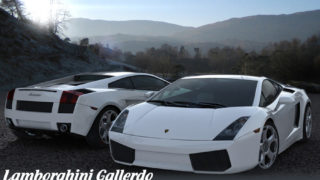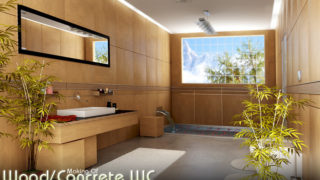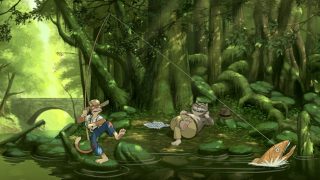
Making of Pink Assassin
On this project I used C4D for modeling and scene setup, ZBrush for sculpting and texture painting as well as fryrender for material creation and rendering. I also used the plug ins “paintonsurface” and “splinespread” for C4D.
IntroductionOn this project I used C4D for modeling and scene setup, ZBrush for sculpting and texture painting as well as fryrender for material creation and rendering. I also used the plug ins “paintonsurface" and “splinespread" for C4D. My intention was to create a character with personality, who looks like she had lived, and tell a story just through her face and not through accessories. For the head and the upper body I used common box modeling (no special techniques here), and did a retopo for the clothes with paintonsurface to get an even mesh of quads. |
Modeling ProcessThe zipper has been modeled in a very simple way with primitive nurbs objects. The zipper parts have been placed with the splinespread plug in which allows (besides many other functions) to clone objects along rail paths. The UV maps were also created with very common pelt mapping techniques, selecting seams and unwrap/relax the mesh. For the head I used the ABF, for the Clothes the LSCSM Algorithm. ABF is a good choice for free painting while LSCSM is better when using tileable Textures. The base meshes were exported to ZBrush to give final shape, create details and paint textures. Mainly I used for sculpting the standard, flatten, clay, smooth and move brush. The flatten and clay brush are very good for roughing shapes. What I like on them, is that especially the flatten brush smoothes the mesh independent of the topology, in opposite to the smooth brush. The move brush is very handy to quickly change the shape of your model. See final sculpting picture below. |
|
|
|
Texturing
The next step was to create the textures for her face. I used ZBrush polypainting for this. First, I started with the colour map. In my opinion the best brush to start painting skin is the standard brush switched to “Colour Spray" with alpha 07 from the “Startup Alphas". I started with simple colours like strong blue, red and yellow, defining some important areas, for example: red for cheeks and lips, blue under the eyes and on the temples. Once I’m happy with my base, I export this as texture at maximum resolution. We will use this later as base for the bump map, it’s also good to have a copy from our work. Then I reduce RGB strength again and paint it over the last time. Because of my realism approach I didn’t paint any SSS faking or shadowing on the map. The result will be a natural skin tone. We can tweak that later with the colour controls in the map editor in fryrender. I also don’t paint any special SSS maps cause I simply tweak the colours in fry’s map editor. |
 |
|
Instead of creating the finest details directly as sculpting, I’ve chosen to use old fashioned bump mapping. For this the previously saved map is the best base. Over this I elaborated the pores, added little wrinkles around the eyes and details for the lips as well. Dark spots are painted over with white, cause they have to appear elevated. The next Maps I needed were specular and roughness maps. The specular map is for a very reflective material layer and defines the gloss on the lips, the wetter lacrimal and the border of the lids. The roughness map is for the main specular, modulating the roughness of this layer. The roughness map can also be regarded as thickness map, cause the reflections of thinner parts are glossier (for example, the front head) and the thicker parts are softer (specular, bump and roughness maps: fig. below). |
 |
|
The last texture I needed is a density map for the head hair and the eyebrows. With this map we can control much better than with polygon selections, where the hair have to grow (see fig below). |
|
 |
A few guides is for a lot of hair, the amount of both is controllable, also the number of segments. Hence each bunch of hair is interpolated for itself, I created more than one hair object to create partings (theres also especially a option for partings which I didnt use here), which makes it much more controllable. Also the eyebrows and lashes are separate hair objects (hair guidews in the final scene: right fig. below)
For the hair I used the C4D hair module. Instead of using it as post effect together with composing techniques, or alpha planes, I’ve decided for the most realistic approach and rendered the hair as polygon strands. |
 |
|
| In C4D you work with so called “hair guides", which can be manipulated with a large toolset of brushes and functions like move, smooth, cut, straighten and so on. With this, you create the look and the hairstyle (some of C4D’s hair tools in fig. above). | |
|
|
|
| As inspiration for my skin material (skinshader) I used the well known MentalRay MISSS FastSkin Shader, which consists of 2 Specular, one Diffuse and 3 SSS Layers. Over the time I made a lot of changes to my skin material, to invite the capabilities of fryrender also on the user’s site (2 specular, diffuse 1, diffuse 2, 3 SSS and the result in fry: fig. below) fryrender is an unbiased render engine. “Unbiased" means that the engine will explore all possible light paths and then produce a complete illumination solution over time. Since the engine explores all paths automatically, everything such as shadows, caustics, colour bleeding and so on will be explored without having to take care from the user’s site. On biased engines those are particular effects that the user has to enable and configure. So with fryrender I have not to bother with a lot of parameters, I just can be sure that everything will be calculated physically correct. | |
 |
|
| Once again I used just a HDR Image for illuminating the scene without any other Lights. Using image based lighting in fryrender is pure fun. Cause of its special acceleration technique “Importance Sampling", you get very crisp lighting and shadows instead of washed out blurry stuff. Once the Image was rendered, I added as very last step subtile grain and chromatic aberration. Like in all my Images, this is the only postwork. I hope you enjoyed my Making-Of. If you have any further questions, you can contact me via my website. | |
About the Artist
Related linksEmail: johnstrieder@web.de Web-site: www.johnstrieder.com Profile: john-strieder.3dm3.com Portfolio: User Portfolio |
 |


 While all this work you should always have photo references in sight. I like to use the freeware program “IrfanView" for viewing pictures. You can set it to “always on top" and place it over the GUI of the program you are currently working in.
While all this work you should always have photo references in sight. I like to use the freeware program “IrfanView" for viewing pictures. You can set it to “always on top" and place it over the GUI of the program you are currently working in.

 John Strieder, born in 1980, is a 3D-Artist and ambitious composer. His work has been included in Exposé 6 and 7, 3D World, Its Art and other publications. Currently hes freelancing mainly for AixSponza, Munich.
John Strieder, born in 1980, is a 3D-Artist and ambitious composer. His work has been included in Exposé 6 and 7, 3D World, Its Art and other publications. Currently hes freelancing mainly for AixSponza, Munich.






